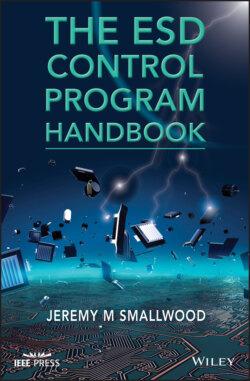Читать книгу The ESD Control Program Handbook - Jeremy M. Smallwood - Страница 83
2.10.3 The Principles of ESD Control
ОглавлениеThe principles of ESD control are remarkably simple. Each principle is aimed at reducing a particular ESD risk.
ESDS are handled only within an electrostatic discharge–protected area (EPA; see Chapter 4) or under ESD‐controlled conditions. This ensures that when ESDS devices are handled, the ESD risks are controlled to an acceptable level.
Outside the EPA in unprotected areas (UPAs), ESD protective packaging is used to protect the ESDS device. The packaging is designed to prevent ESD sources outside the package from having a significant effect on the ESDS device within the package. It also provides a safe region within the package in which ESD risks are controlled.
Within the EPA, ESD risks are controlled by eliminating as far as is possible the sources of ESD likely to damage the ESDS.
Conductors that may touch an ESDS, especially metal items and people, are grounded wherever possible. This ensures that as far as possible, electrostatic voltages on conductors are the same and near zero. This is to prevent them from becoming charged and a source of significant ESD to ESDS devices.
Where conductors cannot be grounded and might contact an ESDS, the voltage difference between the conductor and the ESDS device must be reduced to a sufficiently low level to prevent significant ESD risk.
Electrostatic fields that may occur near ESDS devices are eliminated or reduced to a low level. Insulators that may become charged and the source of electrostatic fields are, where possible, removed from the vicinity of ESDS devices. This is to reduce the risk of induced charging of isolated ESDS devices or other ungrounded conductors.
Items that may contact an ESDS device are preferably made from materials that have appreciable electrical resistance. If ESD occurs, this helps to reduce discharge current to a safe level and absorb much of the discharge energy within the material rather than in the ESDS device.
These measures do not eliminate ESD but help reduce the numbers of ESD occurring, the magnitude of any ESD that occurs, and the likelihood of it damaging the ESDS. Reducing the number of times contact is made with an ESDS device can also help reduce the likelihood of ESD damage occurring. So, the simple measures of not handling the ESDS device any more than necessary and reducing to minimum contact between the ESDS device and other conductors that might be at different voltage can make a useful contribution to reducing ESD risk. If the materials are resistive rather than low resistance where they contact ESDS devices, then a further reduction of risk of ESD damage is made. This is due to reduction of peak current in the discharge and absorption of energy by the resistance of the material.
Suitably specified ESD protective packaging can reduce the risk of ESD damage occurring in the UPA to an insignificant level. The packaging must be specified to address the ESD risks appropriate to the ESDS component or item.
